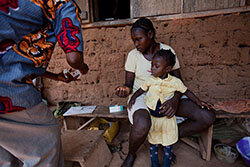Empowering communities to make their own difference

The following was posted on Sightsavers.org in 2012
Picture the scene. There’s a knock at the door - it’s your neighbour. He’s holding a long colourfully painted stick and a notebook and he’s asking you to stand still while he measures you so he can give you the correct dose of a drug he’s carrying. Would you take it?
Now picture the scene again. The same has happened but you’re standing in a village in West Africa. Two fifths of your community are suffering from an itchy skin condition that they developed after being bitten by the small black flies that breed in the rivers near where you live. For some, the infection has affected their sight. Some of them have been blinded by the disease. You know that if you get bitten, you could eventually end up blind like them and your children might have to drop out of school to care for you. You’ve also been considering abandoning your farm and leaving your home village to find a place where collecting water isn’t so risky. But now your neighbour is telling you if you just take his free treatment, you’ll be fine. What would you do now?
This situation is not fiction. 102 million people are at high risk of river blindness in Africa. are at risk from onchocerciasis - or river blindness - with 99 per cent of cases in Africa. More than 300,000 people have already gone blind and about 37 million more people are infected with the disease. But thanks to a community-focused model to combat the disease, over 90 million people have received a life-changing drug that prevents blindness over the past 25 years. And what’s more, that model is now being extended to provide treatment to people in the poorest countries for other neglected tropical diseases (NTDs). As a research paper recently commissioned by Sightsavers has shown, the neighbour with the stick is key to this success.
We’ve been working in Africa to combat river blindness and other NTDs for the past 60 years. The real breakthrough came in 1987, when the treatment Mectizan® (ivermectin*) was donated for mass distribution by global pharmaceutical company Merck & Co. Inc. (known as MSD in the UK). The drug was much needed but it is only one element of a programme that has led to more than 800 million doses being distributed.
By working with local community volunteers, Sightsavers and other non-governmental development organisations (NGDOs) have encouraged affected communities to manage their own treatment programmes. Since there is no one-dose solution to river blindness, we needed to establish programmes that could be sustained for 20 years or more - especially if we are to eventually wipe out river blindness for good. The evidence is now coming in to show that through sustained treatment we are not merely controlling the disease but are interrupting its transmission.
Over the years, the Community-Directed Treatment with Ivermectin (CDTI) model, as it came to be known, showed it could solve many of the problems that hampered traditional health-worker distribution programmes. Distributors from within the community knew, for example, when to target people, and didn’t knock on doors during harvest time, working hours or when the whole village was at a funeral. Volunteers explained that the drugs were not birth control treatments, or other things the community may have been suspicious about, and they were trusted. The system of recording dosages was designed for people without high levels of literacy and calculating dosages of tablets was made easy with coloured height poles, so community members could do their job with confidence. The volunteers received training and refresher training and were supervised and monitored by health workers from nearby health facilities
Through the CDTI model, river blindness endemicity has now been reduced in over 25 countries. In Mali, for example, elimination of river blindness is now a possibility. In Nigeria,river blindness transmission may have already been stopped in the state of Kaduna. Other countries and projects are close too. But beyond this, following the community-directed model has enabled us to reach people suffering from other diseases. The volunteers deliver vitamin A to infants, albendazole to eliminate lymphatic filariasis (or elephantiasis), praziquantel for the control of schistosomiasis, home malaria treatment, distribution of drugs to eliminate blinding trachoma and they assist with cataract referrals - all to help wipe out some of the world’s most debilitating NTDs and other diseases.
Our 25 years of Mectizan®distribution and partnership with community members has shown us the way forward. Last year alone we at Sightsavers trained over 146,500 village-level volunteers in 14 countries, meaning that over 24 million people were treated for river blindness in 2011. Sightsavers NTD programmes also treated other NTDs, with 50 million doses distributed throughout Africa last year.
With the potential to save millions more from what is the world’s second-leading preventable cause of blindness, Sightsavers is committed to continuing and expand this community-embedded programme. Earlier this year we pledged to eliminate the infection and transmission of river blindness in all the countries we support by 2021. It only costs 7p (11 cents) for Sightsavers to prevent someone from going blind from river blindness for a whole year using community distributors - that’s a tiny price for an incredible result. And with the community on board river blindness is not the only NTD we can take on!
*'Mectizan'® (ivermectin) is not licensed for use in the UK.
Please note that Sightsavers' blog posts are the opinions of the author and contributors, meant to encourage debate and discussion, and not Sightsavers' official policy positions, which can be found here.